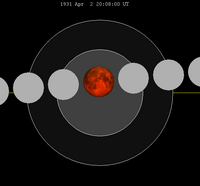| Total eclipse | |||||||||||||||||
 The Moon's hourly motion shown right to left The Moon's hourly motion shown right to left | |||||||||||||||||
| Date | April 2, 1931 | ||||||||||||||||
|---|---|---|---|---|---|---|---|---|---|---|---|---|---|---|---|---|---|
| Gamma | 0.2043 | ||||||||||||||||
| Magnitude | 1.5021 | ||||||||||||||||
| Saros cycle | 121 (51 of 84) | ||||||||||||||||
| Totality | 89 minutes, 36 seconds | ||||||||||||||||
| Partiality | 207 minutes, 50 seconds | ||||||||||||||||
| Penumbral | 317 minutes, 56 seconds | ||||||||||||||||
| |||||||||||||||||
| ← October 1930September 1931 → | |||||||||||||||||
A total lunar eclipse occurred at the Moon’s descending node of orbit on Thursday, April 2, 1931, with an umbral magnitude of 1.5021. A lunar eclipse occurs when the Moon moves into the Earth's shadow, causing the Moon to be darkened. A total lunar eclipse occurs when the Moon's near side entirely passes into the Earth's umbral shadow. Unlike a solar eclipse, which can only be viewed from a relatively small area of the world, a lunar eclipse may be viewed from anywhere on the night side of Earth. A total lunar eclipse can last up to nearly two hours, while a total solar eclipse lasts only a few minutes at any given place, because the Moon's shadow is smaller. Occurring only about 24 hours after perigee (on April 1, 1931, at 22:05 UTC), the Moon's apparent diameter was larger.
Visibility
The eclipse was completely visible over central and east Africa, eastern Europe, and much of Asia, seen rising over west Africa, western Europe, and much of South America and setting over east and northeast Asia and Australia.
 
|
Eclipse details
Shown below is a table displaying details about this particular solar eclipse. It describes various parameters pertaining to this eclipse.
| Parameter | Value |
|---|---|
| Penumbral Magnitude | 2.46366 |
| Umbral Magnitude | 1.50213 |
| Gamma | 0.20432 |
| Sun Right Ascension | 00h44m34.7s |
| Sun Declination | +04°47'34.2" |
| Sun Semi-Diameter | 15'59.8" |
| Sun Equatorial Horizontal Parallax | 08.8" |
| Moon Right Ascension | 12h44m58.7s |
| Moon Declination | -04°36'37.3" |
| Moon Semi-Diameter | 16'38.2" |
| Moon Equatorial Horizontal Parallax | 1°01'03.6" |
| ΔT | 24.0 s |
Eclipse season
See also: Eclipse cycleThis eclipse is part of an eclipse season, a period, roughly every six months, when eclipses occur. Only two (or occasionally three) eclipse seasons occur each year, and each season lasts about 35 days and repeats just short of six months (173 days) later; thus two full eclipse seasons always occur each year. Either two or three eclipses happen each eclipse season. In the sequence below, each eclipse is separated by a fortnight.
| April 2 Descending node (full moon) |
April 18 Ascending node (new moon) |
|---|---|
 |

|
| Total lunar eclipse Lunar Saros 121 |
Partial solar eclipse Solar Saros 147 |
Related eclipses
Eclipses in 1931
- A total lunar eclipse on April 2.
- A partial solar eclipse on April 18.
- A partial solar eclipse on September 12.
- A total lunar eclipse on September 26.
- A partial solar eclipse on October 11.
Metonic
- Preceded by: Lunar eclipse of June 15, 1927
- Followed by: Lunar eclipse of January 19, 1935
Tzolkinex
- Preceded by: Lunar eclipse of February 20, 1924
- Followed by: Lunar eclipse of May 14, 1938
Half-Saros
- Preceded by: Solar eclipse of March 28, 1922
- Followed by: Solar eclipse of April 7, 1940
Tritos
- Preceded by: Lunar eclipse of May 3, 1920
- Followed by: Lunar eclipse of March 3, 1942
Lunar Saros 121
- Preceded by: Lunar eclipse of March 22, 1913
- Followed by: Lunar eclipse of April 13, 1949
Inex
- Preceded by: Lunar eclipse of April 22, 1902
- Followed by: Lunar eclipse of March 13, 1960
Triad
- Preceded by: Lunar eclipse of May 31, 1844
- Followed by: Lunar eclipse of January 31, 2018
Lunar eclipses of 1930–1933
| Descending node | Ascending node | |||||
|---|---|---|---|---|---|---|
| Saros | Date viewing |
Type chart |
Saros | Date viewing |
Type chart | |
| 111 | 1930 Apr 13
|
Partial
|
116 | 1930 Oct 07
|
Partial
| |
| 121 | 1931 Apr 02
|
Total
|
126 | 1931 Sep 26
|
Total
| |
| 131 | 1932 Mar 22
|
Partial
|
136 | 1932 Sep 14
|
Partial
| |
| 141 | 1933 Mar 12
|
Penumbral
|
146 | 1933 Sep 04
|
Penumbral
| |
Saros 121
| This section is empty. You can help by adding to it. (October 2020) |
Half-Saros cycle
A lunar eclipse will be preceded and followed by solar eclipses by 9 years and 5.5 days (a half saros). This lunar eclipse is related to two total solar eclipses of Solar Saros 128.
| March 28, 1922 | April 7, 1940 |
|---|---|

|

|
See also
References
- "April 2–3, 1931 Total Lunar Eclipse (Blood Moon)". timeanddate. Retrieved 16 December 2024.
- "Moon Distances for London, United Kingdom, England". timeanddate. Retrieved 16 December 2024.
- "Total Lunar Eclipse of 1931 Apr 02" (PDF). NASA. Retrieved 16 December 2024.
- "Total Lunar Eclipse of 1931 Apr 02". EclipseWise.com. Retrieved 16 December 2024.
- Mathematical Astronomy Morsels, Jean Meeus, p.110, Chapter 18, The half-saros
External links
- 1931 Apr 02 chart Eclipse Predictions by Fred Espenak, NASA/GSFC


